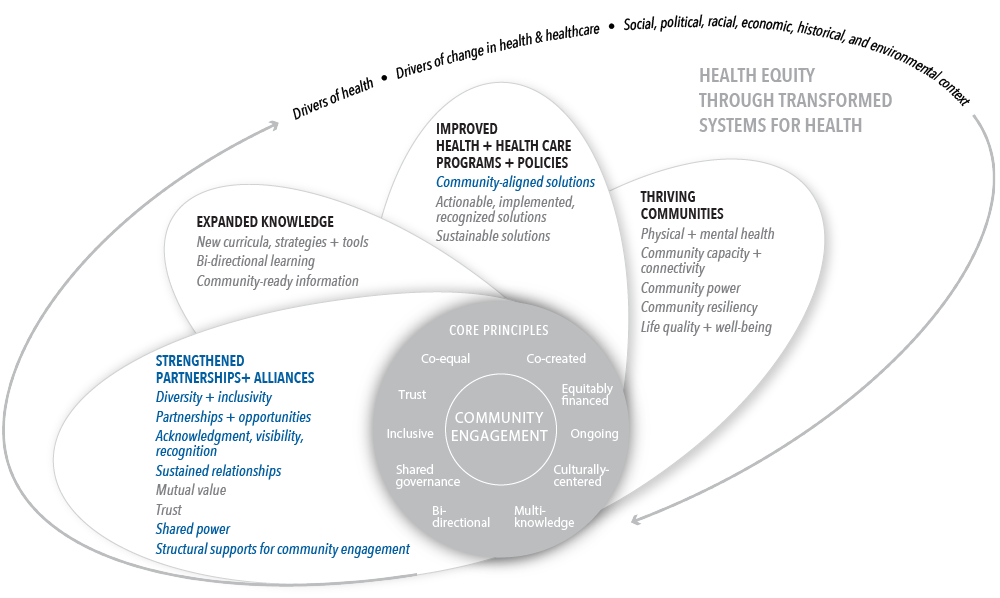Assessing Meaningful Community Engagement
Community-based Participatory Practice Competencies Survey
KEY FEATURES
COMMUNITY/ GEOGRAPHY
Health department employees
North Carolina counties
United States
COMMUNITY ENGAGEMENT OUTCOMES
Strengthened partnerships + alliances
Broad alignment
Diversity + inclusivity
Partnerships + opportunities
Acknowledgment, visibility, recognition
Sustained relationships
Shared power
Structural supports for community engagement
Improved health + health care programs + policies
Community-aligned solutions
PLACE(S) OF INSTRUMENT USE
Local health departments
LANGUAGE TRANSLATIONS
Not specified
PSYCHOMETRIC PROPERTIES
Internal consistency reliability
Factorial validity
YEAR OF USE
1992-1996
Assessment Instrument Overview
The Community-based Participatory Practice Competencies Survey has 20 questions and is used by public health partnerships. It measures the influence of those partnerships on public health organizations and the competencies of each organization and its staff to engage in community-based participatory public health practice.
Alignment with Assessing Meaningful Community Engagement Conceptual Model
The questions from the Community-based Participatory Practice Competencies Survey were realigned to the Assessing Community Engagement Conceptual Model. Figure 1 displays the alignment of the Community-based Participatory Practice Competencies Survey with the Conceptual Model domain(s) and indicator(s). Where an instrument is mapped broadly with a domain or with a specific indicator, the figure shows the alignment in blue font.
Table 1 displays the alignment of Community-based Participatory Practice Competencies Survey’s individual questions and validated focus areas with the Conceptual Model domain(s) and indicator(s). The table shows, from left to right, the aligned Conceptual Model domain(s) and indicator(s), the individual questions from the Community-based Participatory Practice Competencies Survey transcribed as they appear in the instrument (with minor formatting changes for clarity), and the validated focus area(s) presented in the article.
| CONCEPTUAL MODEL DOMAIN(S) AND INDICATOR(S) | ASSESSMENT INSTRUMENT QUESTIONS | VALIDATED FOCUS AREA(S) |
| STRENGTHENED PARTNERSHIPS + ALLIANCES; Broad alignment with all indicators in this domain | 1. How would you rate the skills of your agency in the following areas? Working with community groups | Community-based skills of the health department as a whole |
| 8. How would you rate your own skills in the following areas? Working with community groups | Community-based skills of the individual respondent | |
| STRENGTHENED PARTNERSHIPS + ALLIANCES; Diversity + inclusivity | How would you rate the skills of your agency in the following areas?
| Community-based skills of the health department as a whole |
How would you rate your own skills in the following areas?
| Community-based skills of the individual respondent | |
| STRENGTHENED PARTNERSHIPS + ALLIANCES; Partnerships + opportunities | How often does your agency
| Health department’s networking with other community agencies and groups |
| STRENGTHENED PARTNERSHIPS + ALLIANCES; Acknowledgment, visibility, recognition | 5. How would you rate the skills of your agency in the following areas? Advocating needs in the community | Community-based skills of the health department as a whole |
| 12. How would you rate your own skills in the following areas? Advocating needs in the community | Community-based skills of the individual respondent | |
| 19. Were community members asked for their opinions or perceptions concerning the health status of their community in the latest assessment? | Community participation in health department planning | |
| STRENGTHENED PARTNERSHIPS + ALLIANCES; Sustained relationships | 15. How often does your agency consult community members before new programs are introduced in their community? | |
| STRENGTHENED PARTNERSHIPS + ALLIANCES; Shared power | 16. How often do the programs you work with use feedback from the communities you are serving to make decisions on these programs? | |
STRENGTHENED PARTNERSHIPS + ALLIANCES; Structural supports for community engagement | 18. Does your agency have a regular procedure for residents to give feedback on services and programs? | |
IMPROVED HEALTH + HEALTH CARE PROGRAMS + POLICIES; Community-aligned solutions | 17. How often do the programs you work with address problems identified by the community, when public health statistics point to different problems? | |
| Not aligned with Conceptual Model | How would you rate the skills of your agency in the following areas?
| Community-based skills of the health department as a whole |
How would you rate your own skills in the following areas?
| Community-based skills of the individual respondent |
Table 1 | Community-based Participatory Practice Competencies Survey questions and alignment with the domain(s) and indicator(s) of the Assessing Community Engagement Conceptual Model
ASSESSMENT INSTRUMENT BACKGROUND
Context of instrument development/use
The article states that for local health departments, little guidance is available on how to identify and monitor the necessary skills and competencies for integrating a community-based participatory approach into public health practice and research. The Community-based Participatory Practice Competencies Survey presents one approach to operationalize competencies and measure the capacity and performance of health departments and their staff.
Instrument description/purpose
The Community-based Participatory Practice Competencies Survey measures the influence of partnerships on the organizations and the competencies of each organization and its staff to engage in community-based participatory public health practice using four validated (i.e., factorial) focus areas:
- Community-based skills of the health department as a whole
- Community-based skills of the individual respondents
- Community participation in health department planning
- Health department’s networking with other community agencies and groups
The Community-based Participatory Practice Competencies Survey contains 20 questions with three-point and five-point Likert scales with response options that range from “high” to “low” and “always” to “don’t know.
The Community-based Participatory Practice Competencies Survey can be found here: https://doi.org/10.2105/ajph.93.3.472.
Engagement involved in developing, implementing, or evaluating the assessment instrument
In 1992, a four-year, $16 million Community Based Public Health (CBPH) Initiative was launched by the W.K. Kellogg Foundation. The Initiative was designed to “strengthen linkages between public health education and public health practice by forming formal partnerships with people in communities.” In North Carolina, a consortium comprising “community-based organizations in four counties, their county health departments, and faculty from the School of Public Health, University of North Carolina at Chapel Hill” came together to outline and address the issues identified by county residents. As part of this effort, the consortium developed coalitions with the health departments, community groups, and agency representatives, designed to emphasize a shared decision-making approach. The coalitions identified health problems and strategies to solve those problems. The University of North Carolina Center for Health Promotion and Disease Prevention conducted “a multiple case study participatory evaluation design” and developed and administered the Community-based Participatory Practice Competencies Survey. The first draft of the Community-based Participatory Practice Competencies Survey was developed by evaluation staff with prior experience in assessing community-oriented primary care programs in the United States. It was then shared with members of each coalition to elicit and incorporate their suggestions for additions or revisions to the instrument.
Additional information on populations engaged in instrument use
The Community-based Participatory Practice Competencies Survey was mailed to 429 employees in the health departments of the four counties in North Carolina whose positions required provision of public health services to community members. Employees included staff in “maternal and child health, adult health, health education, dentistry, and sanitation.” The survey had a response rate of 66%, with 282 employees completing and returning the survey.
Notes
- Potential limitations: The items in the Community-based Participatory Practice Competencies Survey focused on a narrow view of assessing community-engaged research, and thus, one limitation of the study is that it was unable to identify “a factor associated with the core public health function of assessment.” Additionally, the study had a 66% response rate from panelists and had to exclude respondents for whom data were missing, resulting in a reduced study sample. A third limitation is that the use of differently worded response categories for the questions to measure quality and quantity “may have affected the psychometric capabilities of the method.”
- Important findings: The study findings highlight the ability of health agencies to operationalize community-based performance and to determine their capacity to be more “community based.” Agencies can use these insights to assess employee skills, provide necessary training, and understand how policies may enhance or hinder community participation. Additionally, policy makers and professionals can “hold health agencies accountable” and ensure that they demonstrate “community basedness.” In order to ensure that health agencies develop and implement programs to enhance the health of the community, “elected officials, community members, public and private funders, and others” should evaluate the community-based capacities, interventions, and other performance activities of these agencies.
We want to hear from you!
Assessing community engagement involves the participation of many stakeholders. Click here to share feedback on these resources, or email [email protected] and include “measure engagement” in the subject line to learn more about the NAM’s Assessing Community Engagement project.
Related Products


